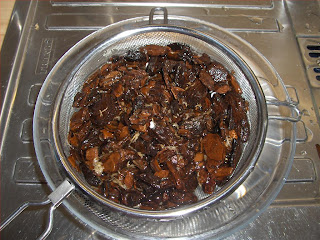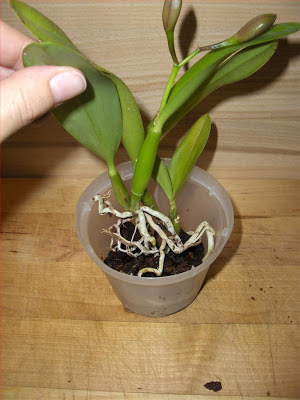The basic steps of my repotting of a Cattleya orchid in bark and sphagnum moss:
- rinse bark under hot running water;
- soak it in osmosis water (or distilled or rain water) at least for one hour;
- let drain off;
- place a first compound layer in the pot;
- place the plant;
- fill the pot without pressing, leaving at least one visible root;
- free the holes at the bottom of the pot;
- cover the exposed roots with some wet sphagnum;
- water soak(or shower from above) when is dry;
- fertilize at normal dose but only during active growing.
 |
| Cattleya orchid, repotting in bark and sphagnum compound |
 |
| Medium bark and sphagnum compound in osmosis water |
 |
| Medium bark and sphagnum compound first layer on the bottom of the pot |
The percentage of sphagnum mixture should be slightly different depending on the needs of the plant and also the conditions of cultivation: in every house there may be lower or higher temperatures and more or less dry air, etc.. Each orchid roots prefer to be more or less dry before being watered again and every grower has his times and his ways to water, in general, we can begin with a mixture of about 80% bark and 20% sphagnum moss and then we will adjust accordingly the drying time and the reactions of the plant.
After all of that let's go to repot!
I use a mixture of bark and sphagnum moss ready for sale in orchids specialized nurseriesbut you can buy bark and sphagnum separately, at exhibitions and trade fairs in orchids or more rarely in normal nurseries, and prepare the mix by yourself.
 |
| Repotting Cattleya orchid in bark and sphagnum moss, placement of the plant |
Since the new bark does not absorb water at all, you need to soak it for at least an hour to moisten it well, since the tap water is often too full of limestone or other elements that can cause serious damages to the orchid roots is better to use RO water (or distilled or rain water).
You place a first layer of mixture on the bottom of the vase and then you place the plant.
The rhizome (the part that joins the pseudobulbs between them) should not be covered by the substrate but placed above.
The Cattleya tend to grow upward then the oldest part of the plant will be almost certainly under the bark, that's okay.
 |
| Repotting Cattleya orchid in bark and sphagnum moss, one root visible through the pot |
Keeping the plant in place you add the mixture of bark and sphagnum moss to fill the vase.
You should never press the bark but only flick the pot to settle the mixture inside.
Once you have filled the jar is essential to free the holes at the bottom with a stick, I do rotate slightly until check up, so I can be sure that there is enough air moving and that water from the watering is able to go out freely don't stay long touching the roots risking to make them rot!
 |
| Repotting Cattleya orchid in bark, free the holes on thebottom of the pot |
 |
 |
| Repotting Cattleya orchid in bark and sphagnum moss cover the exposed roots with some wet sphagnum | |
Good repotting!

No comments:
Post a Comment